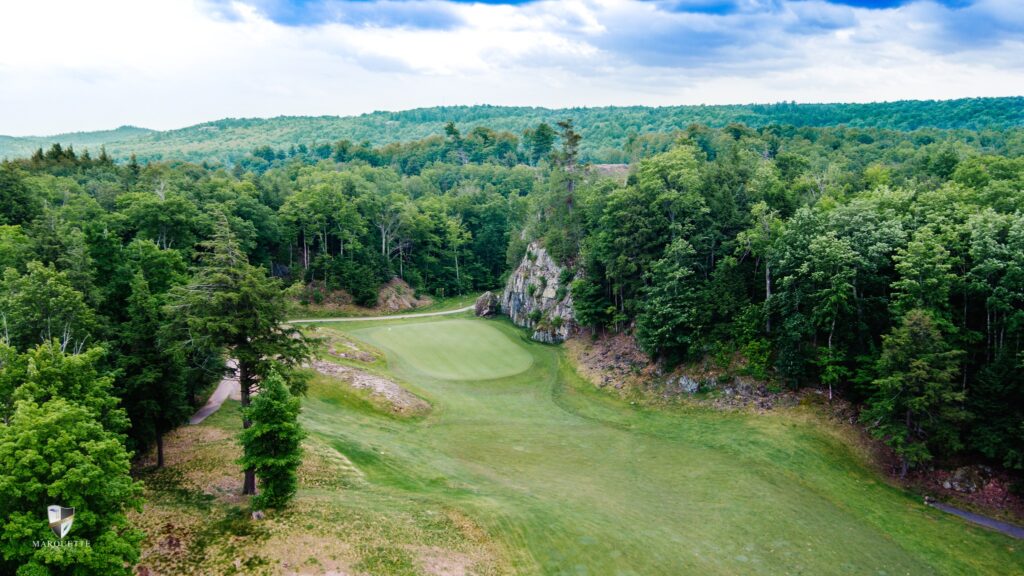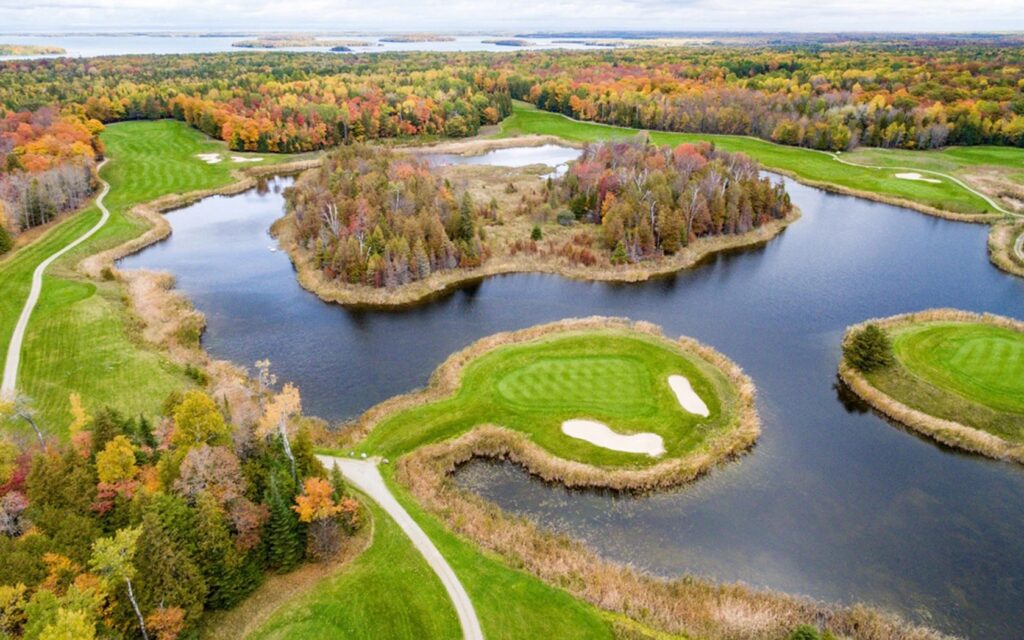
Marquette Golf Club
Michigan’s Upper Peninsula is truly away from it all and the isolation actually contributes to the appeal of the outstanding courses located in the “Land above the Bridge.”
The Upper Peninsula, or UP as the natives call Michigan’s northern third, encompasses almost 30% of the state’s land mass but just 3% of its population. Given the scarcity of folks and the often harsh and lengthy winters, it may surprise some that the region – bordered on the north by Lake Superior, east by the St. Mary’s River, southeast by Lake Michigan and Lake Huron, and west by Wisconsin – has a handful of great courses.
Three of those tracks are profiled here: the Greywalls Course at the Marquette Golf Club, Wild Bluff Golf Course in Brimley in the peninsula’s northeast corner, and The Rock, literally the place to play at the accessible-by-boat-only Drummond Island off the eastern coast of the UP and near Canada.
At all three of the courses golfers are more likely to see wildlife than fellow linksters, although each track draws its fair share of regional players, most of whom get in a round or two in between outdoor pursuits or gaming (Wild Bluff is at the Bay Mills Resort & Casino).
The trio should be considered destination courses since it’s doubtful golfers are just going to stumble upon them. But their remoteness is a plus and getting to either place is worth the effort.
Toning it down makes a difference at Greywalls
It’s truly a blessing when a course architect finds a piece of land with so many potential “highlight” features that some of them need to be toned down to bring the golf element into better focus. Such was the case with Mike DeVries and Greywalls, his course in the town of Marquette and the second of two tracks at the town’s eponymous golf club.
Greywalls, which rolls down steep hills and jagged rock to a verdant valley and wetlands, was built in 2005 and quickly became the featured venue at Marquette Golf Club, which opened in 1926 with the Heritage course and is one of only two 36-hole facilities in the UP.
The site’s natural terrain and massive rock outcroppings gave DeVries, who worked with Tom Doak and was once the groundskeeper at the fine Crystal Downs Country Club downstate, a stage unique in Michigan. Here there are far-reaching vistas of Lake Superior, and often players can even see the Pictured Rocks National Lakeshore some 55 miles into the largest of the Great Lakes.
DeVries had 233 acres at his disposal here but much of that was not usable due to wetlands, a trout stream, ledges and sheer rock walls. These restrictions dictated the routing, which begins on high ground and moves into a rocky transition before heading back to the upper plateau for three holes.
Down in the valley for hole Nos. 11-14, DeVries brings most of the course’s 36 bunkers into play, and the layout ends by heading back into the rocks before closing with a pair of holes that seem simple but demand precision.
During construction DeVries moved just 40,000 cubic yards of dirt and blasted only 3,000 cubic yards of rock on a course that provides a nice mix of vistas, features and strategy.
Greywalls plays just 6,828 yards from its back set of four tees. The track’s hardest holes are three of its two-shotters: the 425-yard second, 489-yard seventh and 491-yard 12th; the 240-yard par-3 15th is surely as testy as the 449-yard 14th.
The view from Greywalls’ first tee sets the stage for the experience ahead as it is set at one of the highest points on the property) and the hole, a 579-yard par 5, tumbles over a ravine to a rolling landing area.
No. 16, a par-4 of just 370 yards, is not long on distance but asks for supreme commitment. Mounding along the right and a wetlands left narrow the landing area, and the 16th’s very large (a square-shaped homage to Donald Ross) green has a gentle front-to-back tilt that seems to repel even short-iron approaches.
The round at Greywalls ends with two holes where a golfer can score with accuracy and verve. The 17th, a tiny 137-yarder, must be attacked to the correct section of its three-segmented putting surface.
The closer is a 533-yard par-5 that plays off an elevated tee over a mound to a mere 22-yard-wide fairway. If the player reaches the short grass, he can make a hearty swing at the green in two, which is defenseless, save for a large knob in the middle of the putting surface that pushes shots to one side or the other. DeVries likens the final two holes as the “calm, flat areas during the final stretch of a rollercoaster ride.”
Some golfers feel the course has a bit of a Scottish feel, and when the wind whips off the nearby huge lake it certainly bears that trait. Because of the many outcroppings bordering and within some fairways, this a demanding course off the tee. But if a player can stay in these well-groomed corridors, Greywalls is infinitely playable.

Greywalls at Marquette Golf Club
Husby takes the high side at Wild Bluff
Wild Bluff Golf Course was designed by Mike Husby and opened in 1998, after which it became one of the top courses in the UP. Husby, a prolific Michigan-based golf architect and management expert, considers Wild Bluff his best work and it’s a blast to play, testing the golfer’s resolve as much as his or her game.
The course borders Hiawatha National Forest and incorporates gently rolling terrain and vistas of nearby Waishkey Bay, St. Mary’s River and Canada. Most of the holes at the par-72, 7,056-yard layout begin atop a bluff, offering scenic views of Lake Superior. The routing presents dramatic elevation changes; even the valley section has rolling, left- and right-turning fairways.
The majority of the holes culminate at elevated greens with tricky surrounds, all factors that contribute to the course’s overall challenge.
Husby throws down the gauntlet at the first five holes – all par 4s. Nos. 3-5 play at 468, 445 and 449 yards, respectively; if one can reach the sixth tee with his game intact and nerves still steady, there are several upcoming chances to make up for this difficult beginning.
No. 12 is a 389-yard par 4 with a green tucked into a forest. Although the hole looks tame on the scorecard, anything wayward off the tee leaves a tough angle into a tiny-looking green guarded by three bunkers. The 209-yard, par-3 15th plunges more than 75 feet to a target squeezed left-front by a huge bunker. Woodlands and a creek enter play here, as does swirling winds.
The 17th, a 556-yard par 5, is crossed by a creek about 200 yards short of the green. Deep bunkers – one before the creek and another past it – tighten the landing area. The 417-yard par-4 closer drops about 100 feet off the tee and sports views of the clubhouse and the bay. There’s more room right of the fairway than left, and a pond short and right of the green enters play on the approach, making the player’s final full swing here one of round’s most demanding.
Wild Bluff and the adjacent Bay Mills Resort & Casino are located about a 30-minute drive west of Sault Saint Marie and only 45 minutes north of the famed Mackinac Bridge. Don’t forget to bring a camera to capture the views of the lake and document those smiles following a successful day at the course.

Wild Bluff
The Rock rocks and rolls on uber-remote Drummond Island
Drummond Island, the largest freshwater island in the United States, sits astride the junction of two of the Great Lakes – Superior on the north and west and Huron to the south. Despite its location at the hub of the region’s shipping lanes, less than 1,000 people reside on the island and there’s no resident police force. It’s a place you have to really want to get to.
More than two-thirds of the island is owned by the state of Michigan, and it’s accessed by ferry at De Tour Village about a two-hour drive from Sault Saint Marie. Not much was here until Tom Monaghan, the late former Domino’s Pizza magnate and Detroit Tigers owner, developed Drummond Island Resort & Conference Center in the 1980s.
Along with the 40-room lodge (called Woodmoor after the island’s old saw mill) and yacht harbor on the island’s north shore, Monaghan also funded the construction of The Rock Golf Course, one of the Wolverine State’s toughest tracks from the back tees and certainly among its most isolated.
Designed by Harry Bowers and opened in 1989, the par-71 layout plays 6,837 yards from the tips. Exceptional holes include the 189-yard par-3 second with its island green; a monster two-shotter at the 476-yard seventh (which narrows as it reaches a triangular-shaped putting surface); and the two short par 4s on the inward half (the 378-yard 14th and 361-yard 16th), both of which are birdie chances with strong drives and shots to the greens.
For the most part, The Rock allows sufficient room off the tee and requires precise iron play. Thick forest enters play near many greens and will severely penalize the wayward. The course is a stern test from the first tee ball to the last putt.
The Rock has beautiful scenery befitting an island dubbed “the Gem of the Huron.” The course winds across more than 400 acres of Drummond Island’s northern forest and offers serene seclusion. Ponds, lakes, wetlands and even a waterfall add to its charm. It may be the toughest course you will ever love – and that’s a good thing.
The resort consists of a main lodge, the Bayside cottages and golf course cabins for rent. If you’re a golfer determined to really get off the beaten track and be tested by a great course, The Rock is just your cup of tea.

The Rock

